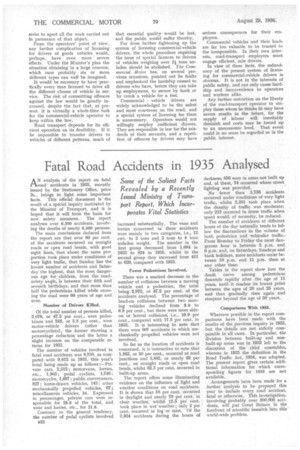Fatal Road Accidents in 1935 Analysed A N analysis of the
Page 32

If you've noticed an error in this article please click here to report it so we can fix it.
report on fatal road accidents in 1935, recently issued by the Stationery Office, price 2s., brings to light some important facts. This official document is the result of a special inquiry instituted by the Minister of Transport, and it is hoped that it will form the basis for new safety measures. The report analyses over 6,300 accidents, involving the deaths of nearly 6,500 persons.
The main conclusions deduced from the report are that over 60 per cent. of theaccidents occurred on straight roads or cpen road bends, with good sight lines, that about the same proportion took place under conditions of very light traffic, that Sunday has the lowest number of accidents and Saturday the highest, that the most dangerous age for children, from the roadsafety angle, is between their fifth and seventh birthdays, and that more than half the pedestrians killed while crossing the road were 60 years of age and over.
. Number of Drivers Killed.
Of the total number of persons killed, 3,079, or 47.5 per cent., were pedestrians and 248, or 3.8 per cent., were motor-vehicle drivers (other than motorcyclists), the former showing a percentage reduction and the latter a slight increase on the comparable returns for 1933.
The number of vehicles involved in fatal road accidents was 8,730, as compared with 9,612 in 1933, this year's total being made up as follows :—Private cars, 2,513; motorvans, lorries, etc., 1,903; pedal cyclists, 1,746; motorcycles, 1,497; public conveyances, 827; horse-drawn vehicles, 143; other mechanically propelled vehicles, 67; miscellaneous vehicles, 34. Expressed in percentages, private cars Were responsible for 28.8 of the total, and vans and lorries, etc., for 21.8.
Contrary to the general tendency, the number of pedal cyclists involved 822
increased substantially. The vans and lorries concerned in these accidents were mainly in two categories, i.e., 12 cwt. to 2 tons and 2 tons to 4 tons unladen weight. The number in the first group decreased from 1,084 in 1933 to 824 in 1935, whilst in the second group they increased from 413 to 629, compared with 1933.
Fewer Pedestrians Involved.
There was a marked decrease in the number of collisions between a moving vehicle and a pedestrian, the total being 2,972, or 47.2 per cent, of the accidents analysed. The percentage of head-on collisions between two moving vehicles declined from 8.9 to 6.9 per cent., but there were mom sideon or lateral collisions, i.e., 19.9 per cent., compared with 17.3 per cent. in 1933. It is interesting to note that there were 607 accidents in which mechanically propelled vehicles were not involved.
So far as the location of accidents is concerned, it is instructive to note that 1,883, or 30 per cent., occurred at road junctions and 3,885, or nearly 62 per cent., on straight roads or open road bends, whilst 62.3 per cent. occurred in built-up areas.
The report offers some illuminating evidence on the influence of light and weather conditions on road accidents. It is shown that 58 per cent, occurred in daylight and nearly 79 per cent, in clear weather,. whilst 12.5 per cent. took place in wet weather ; Only 2 per cent. occurred in fog or mist. Of the 2,824 accidents during the hours of
darkness, 856 were in areas not built up and, of these, 74 occurred where street lighting was provided.
No fewer than 3,736 accidents occurred under conditions of very light traffic, whilst 2,281 took place when the density of traffic was moderate; only 213 occurred in dense traffic when speed would, of necessity, be reduced.
The number of accidents at different hours of the day naturally tends to follow the fluctuations in the volume of both pedestrian and vehicular traffic. From Monday to Friday the most dangerous hour is between 5 p.m. and 6 p.m. and, on Saturdays, Sundays and bank holidays, more accidents occur between 10 p.m. and 11 p.m. than at any other time.
Tables in the report show how the death curve among pedestrians descends rapidly after the age of 11 years, until it reaches its lowest point between the ages of 20 and 25 years, and then gradually rises again and steepens beyond the age of 50 years.
Comparisons With 1933.
Wherever possible in the report comparisons have been made with the results of the previous inquiry in 1933, but the details are not strictly comparable in all cases. In particular, the division between built-up and nonbuilt-up areas was in 1933 left to the discretion of the chief constables, whereas in 1935 the definition in the Road Traffic Act, 1934, was adopted. The present report gives certain additional information for which corresponding figures for 1933 are not available.
Arrangements have been made for a further analysis to be prepared this year to include every road accident, fatal or otherwise. This investigation, involving probably over 200,000 accidents, will put Great Britain in the , forefront of scientific' research into this world-wide problem.




















































































